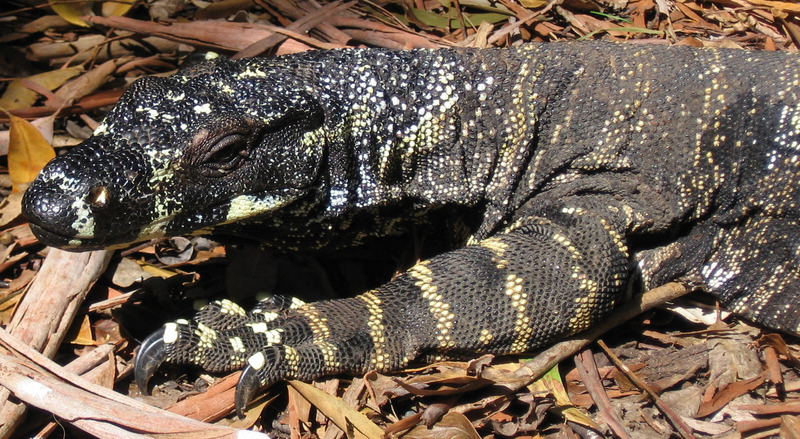Lace monitor
From Wikipedia, the free encyclopedia
[Photo] Lace Monitor or Goanna (Varanus varius). Photo by LiquidGhoul. Date 19 March 2006.
The Lace Monitor, or Lace Goanna, Varanus varius, is a member of the monitor lizard family, Australian members of which are commonly known as goannas.
Lace Monitors, are also known as Lace Goannas in Australia and are the second-largest monitor in Australia after the Perentie. These common terrestrial and often facultatively arboreal monitors are found in eastern Australia and range from Cape Bedford on Cape York Peninsula to south-eastern South Australia. They frequent both open and closed forests and forage over long distances (up to 3 km a day).
They are mainly active from September to May, but are inactive in cooler weather and shelter in a tree hollow or under a fallen tree or large rock.
The females lay from 4 to 14 eggs in spring or summer in termite nests. They frequently attack the large composting nests of Scrub Turkeys to steal their eggs, and often show injuries on their tails inflicted by male Scrub Turkeys pecking at them to drive them away.
The tail is long and slender and about 1.5 times the length of the head and body.
They grow to over 2 metres in total length. Their patterning consists of white spots, blotches or bands on their body. Their distribution is chiefly coastal. Their diet typically consists of insects, reptiles, small mammals, birds and birds' eggs.
In late 2005, University of Melbourne researchers discovered that perenties and other monitors may be somewhat venomous. Previously, it had been thought that bites inflicted by these lizards were simply prone to infection because of bacteria in the lizards' mouths, these researchers are putting forth that this is caused by mild envenomation.
Like all Australian goannas, they were a favorite traditional food of Australian Aboriginal peoples and their fat was particularly valued as a medicine and for use in ceremonies.
http://en.wikipedia.org/wiki/Lace_monitor
| The text in this page is based on the copyrighted Wikipedia article shown in above URL. It is used under the GNU Free Documentation License. You may redistribute it, verbatim or modified, providing that you comply with the terms of the GFDL. |
|

